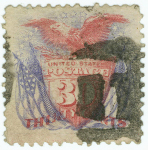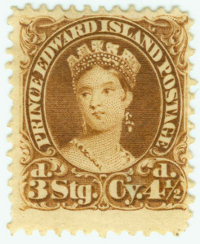
Discussion - Member to Member Sales - Research Center

Discussion - Member to Member Sales - Research Center

David, for instance, put an interesting postmark from Santa Barbara, Calif., up on our auction. I started the bidding war for it.
Here is the link to the offering:
http://www.stamporama.com/cgi-bin/auction/auction.pl?category=covers&item=1257078534
And here is the item:

David describes it as a machine cancel and points out its unusal feature (for a machine cancel): the postmarking dial apparently is mounted sideways.
Well, it actually is debatable if this is a machine cancellation proper. The postmark is from a hand rolling device. Handrolling devices offer a mechanical advantage and some may, thus, consider them machines. I would not, but it really is a gray zone.
The cancelling device employed here is of German origin. I'd really have to dig to find a suitable German counterpart to show. Because these cancels are so common in many European countries I don't recall preserving a cover with such cancellation for reference. However, as far as US cancellations go, it strikes me as an uncommon postmark. Well, prove me wrong: I challenge you to show here another - any other - US cover or individual stamp cancelled by a double rim postmarking dial with date bridge (as shown above).
Smiles,
Arno

Login to Like
this post
Arno,
thanks for the update. I assumed it was a machine cancel, and had never consider roller cancel as a possibility. Interesting to learn of its rarity here and commonness in Europe.
I wouldn't expect Santa Barbara to be a small PO at the time and hence not likely to have supplied its own cancelling devices. Why do you surmise it had this one?
As always, Arno, appreciate the lessons in cancellations.
David

Login to Like
this post
Roller cancellers are really very common in many countries, but you can also find them on US mail mainly on bulky envelopes where neither a machine or handcancel would work well. It is just this particular style of a roller postmark that I would consider uncommon. I just don't recall to have seen many of these German-style double rim roller cancellers on American mail (if any at all -- therefore my challenge).
The purchase of this device certainly is pre-war and from the 1945 cancellation date we can thus deduct that it was used at least for a couple of years. Since Santa Barbara is not a small town, it may be an uncommon postmark, but probably not scarce or rare.
Santa Barabra certainly was a first or second class post office that was supplied with standardized postmarking equipment. However, postmasters of any post office small or large had a descretionary fund and at times used it to purchase equipment that they believed provided an advantage even if they were 'offically' not supplied with that equipment from the Postal Department. So, not knowing anything else, I suggest that the canceller indeed was acquired privately. If I come across any new pertinent information I will certainly post it here. Again, I have no really secured information on this postmark; it just looks unfamiliar.

Login to Like
this post
I still owe information on the other postmark David asked about. It is also currently offered on our auction:
http://www.stamporama.com/cgi-bin/auction/auction.pl?category=covers&item=1257078338
And here is the image:

It is a postmark impressed by a fast electric (medium-grade) cancellation machine manufactured by the Columbia Postal Supply Company of Silver Creek, New York.
Columbia electric machines were fitted with this particular style predominantly in the period from mid-1913 to mid-1918. Columbia had supplied a varying number of machines to the Postal Department on a rental basis since 1900. In 1913 the company secured a major contract to supply 305 electric and 100 hand-cranked rental machines for the four year contract from July 1, 1913 to June 30, 1917. When the contract ran out the lease on some machines was extended by a year, but by that time the POD had decided in principle to purchase rather than rent machines in the future annd to not favor Columbia with such purchases. The Columbia Postal Suppy Co. -- aware that no future business with the POD would be forth coming -- focused all it's energy on the development and marketing on small hand-driven (later electric) machines for the use in small 3rd and 4th class post offices. They were very successful at that. In terms of numbers of machines in service Columbia ranks number one among all American makers of cancellation machines.
The hand-driven Columbias are difficult to collect, due to their large number and the very low number of mail handled in the post offices targeted by the company. They are also rather dull in appearance and not easy to distinguish from other machines -- circular postmarks with mostly seven wavy lines.
The electric Columbia machines -- around from 1900 to pretty much 1918 are more fun from my perspective. They have distinctive designs, one of which is the shown straight line postmark with an eight-bar canceller. Being fast electric machines, they were used in towns of size -- albeit not in the largest cities were high-grade International or Universal machines were preferred. Columbia machines were also marketed successfully in other countries, particularly the UK.
Because of some movement of machines among post offices, I estimate that no more than 350 towns should have used Columbia machines with a postmark of the "Oneida" style. It is not a rare type of cancel. Specimens can be found quite easily. You also find them quite frequently on postcards. The recent offering had me go back to my box of Columbia's and I counted 75 different towns so far. Let's see how it goes with the auction, but I hope to make it 76.

Login to Like
this post

I am starting this thread on US postmarks to have a home for future related postings. I am very much into postmarks, which are my coils so to speak ;). It is really hard for me not to comment on any interesting postmarks I come across here.
David, for instance, put an interesting postmark from Santa Barbara, Calif., up on our auction. I started the bidding war for it.
Here is the link to the offering:
http://www.stamporama.com/cgi-bin/auction/auction.pl?category=covers&item=1257078534
And here is the item: 
David describes it as a machine cancel and points out its unusal feature (for a machine cancel): the postmarking dial apparently is mounted sideways.
Well, it actually is debatable if this is a machine cancellation proper. The postmark is from a hand rolling device. Handrolling devices offer a mechanical advantage and some may, thus, consider them machines. I would not, but it really is a gray zone.
The cancelling device employed here is of German origin. I'd really have to dig to find a suitable German counterpart to show. Because these cancels are so common in many European countries I don't recall preserving a cover with such cancellation for reference. However, as far as US cancellations go, it strikes me as an uncommon postmark. Well, prove me wrong: I challenge you to show here another - any other - US cover or individual stamp cancelled by a double rim postmarking dial with date bridge (as shown above).
Smiles,
Arno

Login to Like
this post
Auctions
re: US postmarks --tidbits
Arno,
thanks for the update. I assumed it was a machine cancel, and had never consider roller cancel as a possibility. Interesting to learn of its rarity here and commonness in Europe.
I wouldn't expect Santa Barbara to be a small PO at the time and hence not likely to have supplied its own cancelling devices. Why do you surmise it had this one?
As always, Arno, appreciate the lessons in cancellations.
David

Login to Like
this post

re: US postmarks --tidbits
Roller cancellers are really very common in many countries, but you can also find them on US mail mainly on bulky envelopes where neither a machine or handcancel would work well. It is just this particular style of a roller postmark that I would consider uncommon. I just don't recall to have seen many of these German-style double rim roller cancellers on American mail (if any at all -- therefore my challenge).
The purchase of this device certainly is pre-war and from the 1945 cancellation date we can thus deduct that it was used at least for a couple of years. Since Santa Barbara is not a small town, it may be an uncommon postmark, but probably not scarce or rare.
Santa Barabra certainly was a first or second class post office that was supplied with standardized postmarking equipment. However, postmasters of any post office small or large had a descretionary fund and at times used it to purchase equipment that they believed provided an advantage even if they were 'offically' not supplied with that equipment from the Postal Department. So, not knowing anything else, I suggest that the canceller indeed was acquired privately. If I come across any new pertinent information I will certainly post it here. Again, I have no really secured information on this postmark; it just looks unfamiliar.

Login to Like
this post

re: US postmarks --tidbits
I still owe information on the other postmark David asked about. It is also currently offered on our auction:
http://www.stamporama.com/cgi-bin/auction/auction.pl?category=covers&item=1257078338
And here is the image:

It is a postmark impressed by a fast electric (medium-grade) cancellation machine manufactured by the Columbia Postal Supply Company of Silver Creek, New York.
Columbia electric machines were fitted with this particular style predominantly in the period from mid-1913 to mid-1918. Columbia had supplied a varying number of machines to the Postal Department on a rental basis since 1900. In 1913 the company secured a major contract to supply 305 electric and 100 hand-cranked rental machines for the four year contract from July 1, 1913 to June 30, 1917. When the contract ran out the lease on some machines was extended by a year, but by that time the POD had decided in principle to purchase rather than rent machines in the future annd to not favor Columbia with such purchases. The Columbia Postal Suppy Co. -- aware that no future business with the POD would be forth coming -- focused all it's energy on the development and marketing on small hand-driven (later electric) machines for the use in small 3rd and 4th class post offices. They were very successful at that. In terms of numbers of machines in service Columbia ranks number one among all American makers of cancellation machines.
The hand-driven Columbias are difficult to collect, due to their large number and the very low number of mail handled in the post offices targeted by the company. They are also rather dull in appearance and not easy to distinguish from other machines -- circular postmarks with mostly seven wavy lines.
The electric Columbia machines -- around from 1900 to pretty much 1918 are more fun from my perspective. They have distinctive designs, one of which is the shown straight line postmark with an eight-bar canceller. Being fast electric machines, they were used in towns of size -- albeit not in the largest cities were high-grade International or Universal machines were preferred. Columbia machines were also marketed successfully in other countries, particularly the UK.
Because of some movement of machines among post offices, I estimate that no more than 350 towns should have used Columbia machines with a postmark of the "Oneida" style. It is not a rare type of cancel. Specimens can be found quite easily. You also find them quite frequently on postcards. The recent offering had me go back to my box of Columbia's and I counted 75 different towns so far. Let's see how it goes with the auction, but I hope to make it 76.

Login to Like
this post

